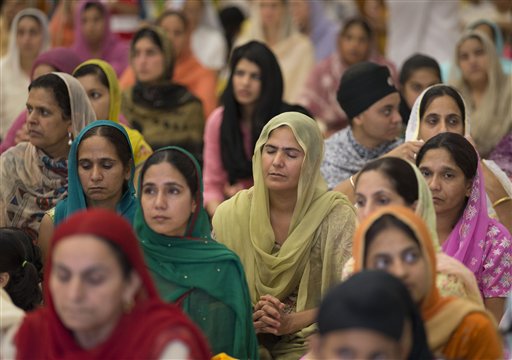MILWAUKEE — The Sikh temple where a white supremacist killed six people earlier this month has been largely repaired. A crisp new American flag flies out front, prayer services have returned to a normal schedule and walls once scarred by gunfire are now covered with banners of support from around the world.
While the Sikh community in this Milwaukee suburb continues to mourn the dead, they have taken solace in one fact: The killing has drawn attention to their religion and given them a chance to share traditional Sikh messages of peace and justice with a global audience. A scheduled visit Thursday by first lady Michelle Obama offers one more opportunity to preach unity and compassion.
“There’s a prayer we say twice a day, asking God to please give peace to everybody and give progress to every person in this birth,” said Inderjeet Singh Dhillon, one of the temple leaders. “We don’t mention a person’s name or color or religion. We just say one word for every human on Earth.”
There are an estimated 200,000 to 500,000 Sikhs living in America. However, it’s not uncommon for Sikhs to keep to themselves, leaving non-Sikhs to wonder from afar about Sikh customs — for example, why the men might have long beards and wear turbans.
Sikh leaders in the U.S. have tried to change that. They have encouraged people of all faiths to visit their temples and sit with them on the floor to partake of free meals. One of those leaders was Satwant Singh Kaleka, the president of the Sikh Temple of Wisconsin and one of the six people killed Aug. 5.
Kaleka tried to fight off the gunman with a butter knife, buying time for others to hide in the temple. The gunman, white supremacist Wade Michael Page, later killed himself during an ensuing gun battle with police.
Kaleka’s son, Amardeep Kaleka, said the gunman may have sought to divide the community, but his actions backfired.
Addressing a crowd of hundreds at a candlelight vigil two days after the shooting, he said his father would have been thrilled to see so many Sikhs and non-Sikhs coming together as one.
“He’s probably up there thinking, ‘Great, everybody’s together,'” Amardeep Kaleka said. He added that his father was educating more people about Sikhism in death than he was able to in life.
Michelle Obama was scheduled to meet privately Thursday with families of those wounded and killed. Rajwant Singh, the chairman of the Maryland-based Sikh Council on Religion and Education, said her visit was a welcome gesture.
“It is important that these families hear firsthand how she and the president feel about this terrible tragedy,” he said.
In the weeks after the shooting, well-wishers from around the globe have sent cash, flowers and banners of support. They have also sent cards on behalf of Police Lt. Brian Murphy, the Oak Creek officer who was among the first to respond to 911 calls from the temple.
Page shot Murphy nine times from close range before shooting himself in the head after being wounded. When other officers tried to tend to Murphy, he tried to wave them off and direct them to help worshippers indoors instead.
Murphy was released from the hospital Wednesday. A hospital spokeswoman said Murphy had requested that the media respect his privacy.
A second shooting victim remains in critical condition. A third was released last week and the fourth was treated for minor injuries on the day of the shooting.
Send questions/comments to the editors.


